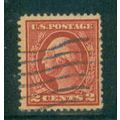Animal - Asian short-clawed Otter - WWT postcard
- Condition : Used
- Dispatch : 2 Days
- Brand : None
- ID# : 93647670
- Quantity : 1 item
- Views : 324
- Location : United Kingdom

- Seller : justthebook (+1699)
- Barcode : None
- Start : Sat 23 Feb 2013 15:42:54 (EDT)
- Close : Run Until Sold
- Remain : Run Until Sold
Checks/Cheques
 for 1 item(s) edit
for 1 item(s) edit
Shipping Calculator
More Listings from This Seller view all
Seller's Description
- Postcard
- Picture / Image: Asian Short-Clawed Otter
- Publisher: Wildfowl & Wetlands Trust (WWT), c.2000s
- Postally used: no
- Stamp: n/a
- Postmark(s): n/a
- Sent to: n/a
- Notes / condition: as new
Check out my !
Please ask if you need any other information and I will do the best I can to answer.
------------------------------------------------
Postage & Packing:
UK (incl. IOM, CI & BFPO): 99p
Europe: £1.60
Rest of world (inc. USA etc): £2.75
No additional charges for more than one postcard. You can buy as many postcards from me as you like and you will just pay the fee above once. (If buying postcards with other things such as books, please contact or wait for invoice before paying).
Payment Methods:
UK - PayPal, Cheque (from UK bank) or postal order
Outside UK: PayPal ONLY (unless otherwise stated) please. NO non-UK currency checks or money orders (sorry).
NOTE: All postcards are sent in brand new stiffened envelopes which I have bought for the task. These are specially made to protect postcards and you may be able to re-use them. In addition there are other costs to sending so the above charge is not just for the stamp!
I will give a full refund if you are not fully satisfied with the postcard.
----------------------------------------------
Text from the free encyclopedia WIKIPEDIA may appear below to give a little background information (internal links may not work) :
*************
The oriental small-clawed otter (Aonyx cinerea), also known as the Asian small-clawed otter, is the smallest otter species in the world,[3] weighing less than 5 kg. It lives in mangrove swamps and freshwater wetlands of Bangladesh, Burma, India, southern China, Taiwan, Laos, Malaysia, Indonesia, the Philippines, Thailand, and Vietnam.[1] Its paws are a distinctive feature, its claws not extending beyond the fleshy end pads of its partially webbed fingers and toes. This gives it a high degree of manual dexterity so that it can use its paws to feed on molluscs, crabs and other small aquatic animals.
The oriental small-clawed otter lives in extended family groups with only the alpha pair breeding; offspring from previous years help to raise the young. Due to ongoing habitat loss, pollution, and hunting in some areas, the oriental small-clawed otter is evaluated as vulnerable on the IUCN Red List of Threatened Species.[2]
This species was formerly thought to be the only member of the genus Amblonyx;[1] however, it has recently been confirmed as being a member of the genus Aonyx after mitochondrial DNA analysis.[4] Another synonym for the oriental small-clawed otter is Aonyx cinereus.
Oriental small-clawed otters are the smallest of all otters in the world. The overall length can range from 70 to 100 cm (28–39 in), of which about 30 cm (12 in) is the tail. Weight can range from 1 to 5.4 kg (2.2-11.9 lbs).[6] The body is slender, streamlined and serpentine, and is flexible enough to allow grooming of almost all the body. Dark, grayish-brown fur covers most of the dorsal surface with a lighter cream coloration on the ventral surface, especially on the face and neck. The fur has relatively short hairs less than 2.5 cm in length, and it is fine, dense and velvety. Otters have two types of fur: long, stout guard hairs and a short, fine undercoat.
Oriental small-clawed otters have flattened heads and short, thick necks; eyes are located toward the front of the head. The ears are small and rounded and have a valve-like structure that enables them to be closed when swimming underwater. Nose pads are dusky or pinkish in color. The muzzle has vibrissae (whiskers) on either side. These are sensitive to touch and to underwater vibrations, and are important in detecting the movements of prey.
Similar to other otters, oriental small-clawed otters have relatively short legs, which are used to swim, walk, groom and manipulate prey. Feet are very narrow and only webbed to the last joint — not all the way to the end of the toe and this distinguishes them from all other species of otter. These partially webbed paws give them an excellent sense of touch and coordination, providing them with more dexterity than other otters with full webbing. Unlike other otters, they catch their prey with their paws instead of with their mouth. Their small, blunt, peg-like claws are extremely reduced and rarely extend past the tips of the digits.
The oriental small-clawed otter's tail is long, about one-third of its total body length. The tail is thick at the base, muscular, flexible, and tapers to a point. Subcutaneous and scent glands are located at the base of the tail. The tail is used for propulsion when swimming at high speed, to steer when swimming slowly and for balance when standing upright on hind legs.
type=printed postcards
theme=animals
sub-theme=otters
number of items=single
period=1945 - present
postage condition=unposted
Listing Information
| Listing Type | Gallery Listing |
| Listing ID# | 93647670 |
| Start Time | Sat 23 Feb 2013 15:42:54 (EDT) |
| Close Time | Run Until Sold |
| Starting Bid | Fixed Price (no bidding) |
| Item Condition | Used |
| Bids | 0 |
| Views | 324 |
| Dispatch Time | 2 Days |
| Quantity | 1 |
| Location | United Kingdom |
| Auto Extend | No |













